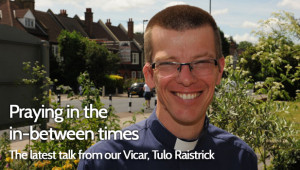Heb 5:5-10; John 12:20-33
5th Sunday of Lent
St Barbara’s 22.03.15
One of the joys of autumn every year are the chestnuts that fall to the ground.
As a child, and still as an adult, I love picking them up, collecting them, cleaning them, polishing them in my gloves. Where we used to live in London, the walk home from school would take us past twenty or so chestnut trees, and by the time we got home, the children’s school bags and pockets would be weighed down with hundreds of them.
What did we do with them all? Well, many we would line up on our window-sills and just enjoy their beautiful deep-brown colour and smooth shapes. The children were adamant too that conkers were a good way of keeping spiders away, of which our previous house was full, so I would find conkers tucked into almost every corner of the house. And of course some would have a string attached to them and be used for conker fights.
But for all the beauty and the joy they brought, that was not their purpose. Their purpose was something all the more remarkable, something all the more beautiful. From these conkers if planted rightly, would come a tiny shoot that would grow into a little sapling, that over time would grow into a wonderful tree, producing fresh horse chestnuts of its own. That was their true purpose. For the conker, the seed, to be buried in the ground, to die, so that from it may come new life.
It is the analogy that Jesus uses in our gospel reading.
Jesus has been living a life of great beauty and vitality, a life that has brought healing to the sick, hope to the despairing. He has taught people about God, he has transformed the lives of those most despised in the community, he has shown love and welcome to all. But that is not his primary purpose.
Like the conker, like the grain of wheat, his primary purpose is not to be admired or valued. It is to die. That is why God sent his son into our world.
At the wedding of Cana, where he does the first of his miracles, he says, “My time has not yet come.” When he is teaching to crowds, John tells us “Nobody arrested him because his time had not yet come.” But now, with his enemies wanting him dead, Jesus says: “my time has come”. Jesus’ death is not an accident that wasn’t supposed to happen; nor is it a derailment of God’s plans; nor is it a Plan B. The cross is the purpose for which Christ has come. It is not the damp-squib ending to his ministry of healing and teaching. At first sight Christ’s death may seem a senseless, meaningless end to an incredible life, just as burying a beautiful conked in the ground rather than keeping it to admire and delight in, may seem such a waste. But his ministry of healing and teaching has all been leading up to this point. This is why he came.
For like the conker or the seed of wheat, in dying Christ makes abundant life possible. In dying and rising from the dead Christ looks sin and death itself in the face and defeats it on behalf of the whole world. The cross is the crux of history, the place where death is overcome, and the gift of eternal life free from sin is made possible. It is why Christ came into our world. It is where God is most truly glorified, in an act of extraordinary self-giving love and sacrifice.
It comes at great cost. John does not record the events of the Garden of Gethsemane in his gospel, but this is his equivalent, as Jesus prays: “Now my heart is troubled, and what shall I say? “Father, save me from this hour?”” Jesus, as he looked ahead to what was to come, longed for an easier way, a way of less suffering and grief. Jesus knew the weakness, the doubts, the struggles of being human. He knew how hard it could be to do God’s will, to live as God wanted him to. But such is his extraordinary love for us, such his willingness to make whatever sacrifice that we might have life, he comes to the point of being able to say: “It was for this very reason I came to this hour. Father, glorify your name!” Jesus is willing to drink from the cup of suffering, he is willing to face death itself, so that we might have life.
As we enter into this period of Passiontide, and as our thoughts and prayers centre ever more strongly on the cross of Christ, may we once again find ourselves marvelling at the love, the mercy, the abundant self-giving of Christ, that should lead to the cross. Take time over these next two weeks to consider again just what it meant for Christ to go to the cross.
And as you do so, remind yourself once more. This is not a story of things going tragically wrong. This is the story of a Christ willing to pay whatever price, that from his death might come life, and life in all its fullness.

